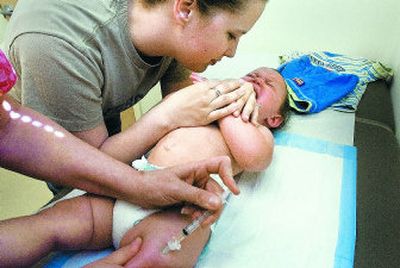Shot support

Moms and dads, keep this in mind when you take your kids to the doctor for a shot:
If the thought of that needle leaves you white-faced and rushing for the door, your child will likely feel the same way.
“Parents need to remember that they’re the ones that set the tone for the child,” says Jan DeLeeuw, a certified child-life specialist at Sacred Heart Children’s Hospital in Spokane. “If they begin to get anxious and have their own fears and frights, the child picks up on that.”
A study out this month in the journal Pediatrics bears that out. Researchers found that jokes, bubbles, and, in the smallest babies, sugar water, work better at soothing young patients than great displays of sympathy.
“Excessive parental reassurance, criticism or apology seems to increase distress, whereas humor and distraction tend to decrease distress,” the authors write.
The researchers, headed by Dr. Neil Schechter of the Pain Relief Program at Connecticut Children’s Medical Center, examined the best strategies for limiting anxiety and pain caused by immunizations for babies up to older children.
“(I)mmunizations are the most frequently occurring painful procedures performed in pediatric settings,” the authors write.
That’s no surprise to anyone who has taken an infant or child to a check-up. The Centers for Disease Control and Prevention recommend kids under the age of six be vaccinated against 10 different diseases, many requiring multiple injections at different visits. Often, a child will receive three separate shots during one exam.
That was the case for little Noah Hunt one recent afternoon. Hunt, who had just celebrated his first birthday, didn’t know it, but his mom had brought him to the Group Health Lidgerwood Medical Center in North Spokane for three shots – varicella (chickenpox), hepatitis A, and measles, mumps and rubella.
Noah’s mother, Ashley Hunt, laid her diaper-clad baby on the examining table. She perched her head over his and held his hands as he whined, cried and then screamed while he got the injections.
But in a few seconds, it was all over. Noah was quiet. He sucked on a pacifier and got a hug from his mom.
Toni Piacquaddio, a certified medical assistant who gave Noah his one-year shots, has been vaccinating kids for 26 years.
Her strategies vary depending on the age of the child, Piacquaddio says. She encourages parents to be comforting during the procedure, but not to feel guilty about the few seconds of pain their child must go through.
“Let moms know they are doing a good thing for their child’s health,” she says.
Piacquaddio says she uses gentle touch to reassure the smallest patients. She urges parents to do just as Ashley Hunt did, to bend over the exam table to hold and comfort their babies.
For older kids, she might strike up conversation about their plans after the doctor’s visit. Or she’ll tell jokes. And she always explains each step of what she’s doing.
“You want them to trust you,” Piacquaddio says.
And when they ask her, “Will it hurt?” she always says, “Yes, it will, a little bit.”
“If you say ‘no’ and it does, you’ll lose their trust,” she says.
Here are some of the other findings from the article in Pediatrics:
•Prepare the child in advance of the shot in an age-appropriate manner. Toddlers and pre-schoolers should be told about the shot as close to the event as possible, to minimize anxiety.
•Once in the exam room, children should be told what will happen, how it will feel and strategies to cope with the pain.
•Distraction, such as playing with a toy or blowing bubbles, can minimize the sting.
•Before the age of 4 to 6 months, sugar water eases pain. It can be given via pacifier or injected into the mouth with a small syringe. Breastfeeding has also been shown to help with pain management.
•In some cases of extreme anxiety, numbing cream can be used.
Piacquaddio says she never uses the numbing crèam because it takes up to 20 minutes to become effective and, in that time, the shots could be finished.
But DeLeeuw says the cream is useful at Sacred Heart for the most apprehensive patients. Mostly, though, she relies on distraction techniques.
She asks kids of all ages to pretend they’re blowing out birthday candles while getting a shot.
“That’s tried and true,” she says. “It’s valid for a young toddler to teenagers.”
Or she shows them books or blows bubbles.
For older children and teens, she reminds them that much of the anxiety is in their head. And, most of the time, they tell her “that’s not half as bad as I was expecting.”